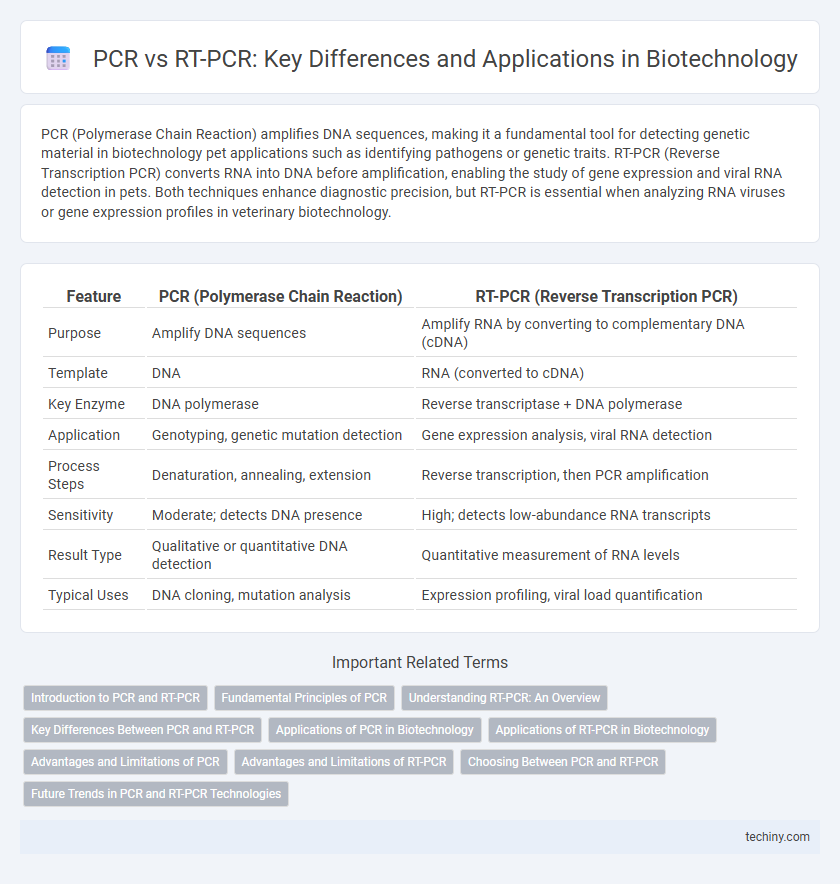PCR (Polymerase Chain Reaction) amplifies DNA sequences, making it a fundamental tool for detecting genetic material in biotechnology pet applications such as identifying pathogens or genetic traits. RT-PCR (Reverse Transcription PCR) converts RNA into DNA before amplification, enabling the study of gene expression and viral RNA detection in pets. Both techniques enhance diagnostic precision, but RT-PCR is essential when analyzing RNA viruses or gene expression profiles in veterinary biotechnology.
Table of Comparison
| Feature | PCR (Polymerase Chain Reaction) | RT-PCR (Reverse Transcription PCR) |
|---|---|---|
| Purpose | Amplify DNA sequences | Amplify RNA by converting to complementary DNA (cDNA) |
| Template | DNA | RNA (converted to cDNA) |
| Key Enzyme | DNA polymerase | Reverse transcriptase + DNA polymerase |
| Application | Genotyping, genetic mutation detection | Gene expression analysis, viral RNA detection |
| Process Steps | Denaturation, annealing, extension | Reverse transcription, then PCR amplification |
| Sensitivity | Moderate; detects DNA presence | High; detects low-abundance RNA transcripts |
| Result Type | Qualitative or quantitative DNA detection | Quantitative measurement of RNA levels |
| Typical Uses | DNA cloning, mutation analysis | Expression profiling, viral load quantification |
Introduction to PCR and RT-PCR
Polymerase Chain Reaction (PCR) amplifies specific DNA sequences using thermal cycling, DNA primers, nucleotides, and DNA polymerase, enabling rapid and precise detection of genetic material. Reverse Transcription PCR (RT-PCR) extends this technique by converting RNA into complementary DNA (cDNA) via reverse transcriptase, facilitating the analysis of gene expression and RNA viruses. Both methods are fundamental in molecular biology, diagnostics, and biotechnology research for detecting and quantifying nucleic acids.
Fundamental Principles of PCR
Polymerase Chain Reaction (PCR) amplifies specific DNA sequences by cycling through denaturation, annealing, and extension phases using a thermostable DNA polymerase. This method requires DNA as a template, unlike RT-PCR which first converts RNA into complementary DNA (cDNA) using reverse transcriptase. The fundamental principle of PCR relies on the precise thermal cycling to exponentially replicate target DNA fragments, enabling sensitive and specific genetic analysis.
Understanding RT-PCR: An Overview
RT-PCR (reverse transcription polymerase chain reaction) enhances traditional PCR by converting RNA into complementary DNA (cDNA) using reverse transcriptase, enabling the amplification of RNA sequences. This technique is essential for detecting and quantifying gene expression, viral RNA, and other RNA-based targets with high sensitivity and specificity. RT-PCR's ability to measure RNA makes it indispensable in diagnostics, molecular biology research, and clinical applications.
Key Differences Between PCR and RT-PCR
PCR amplifies specific DNA sequences using thermal cycling, while RT-PCR converts RNA into complementary DNA (cDNA) before amplification, enabling analysis of gene expression. PCR targets DNA directly, making it suitable for detecting DNA mutations or pathogens, whereas RT-PCR is essential for quantifying RNA transcripts and studying gene expression dynamics. The inclusion of a reverse transcription step in RT-PCR distinguishes it functionally and methodologically from standard PCR.
Applications of PCR in Biotechnology
PCR amplifies specific DNA sequences for applications such as genetic cloning, mutation analysis, and forensic identification. It enables the detection of genetically modified organisms (GMOs) and the diagnosis of infectious diseases by identifying pathogen DNA. Real-time PCR (qPCR) quantifies DNA, while RT-PCR converts RNA into DNA, crucial for studying gene expression and RNA viruses in biotechnology.
Applications of RT-PCR in Biotechnology
RT-PCR plays a crucial role in biotechnology by enabling precise quantification of gene expression, facilitating the detection of RNA viruses, and assisting in the development of genetically modified organisms. This technology is extensively used in medical diagnostics, such as identifying infectious diseases and monitoring cancer biomarkers. Its ability to convert RNA into complementary DNA before amplification allows researchers to study dynamic gene activity and regulatory mechanisms in various biological systems.
Advantages and Limitations of PCR
PCR offers rapid amplification of specific DNA sequences with high sensitivity, enabling detection of minute genetic material quantities. Its limitations include inability to distinguish between DNA and RNA, requiring additional steps for RNA analysis, and potential amplification errors due to contamination or primer design. PCR's robustness and cost-effectiveness make it ideal for DNA analysis, but it lacks the capacity to directly quantify gene expression like RT-PCR.
Advantages and Limitations of RT-PCR
RT-PCR offers superior sensitivity and specificity by converting RNA into complementary DNA, enabling precise quantification of gene expression and detection of RNA viruses like SARS-CoV-2. Its ability to analyze dynamic RNA levels in real-time makes it indispensable for diagnostic and research applications, despite higher costs and technical complexity compared to standard PCR. Limitations include susceptibility to contamination, requirement for high-quality RNA samples, and challenges in primer design to avoid non-specific amplification.
Choosing Between PCR and RT-PCR
Choosing between PCR and RT-PCR depends largely on the target nucleic acid: PCR amplifies DNA sequences, making it ideal for analyzing genomic DNA or DNA viruses, while RT-PCR is essential for detecting and quantifying RNA by first converting it into complementary DNA (cDNA) using reverse transcriptase. RT-PCR offers higher sensitivity for gene expression studies, RNA virus detection, and transcriptomics, whereas PCR is preferred for applications where the starting material is DNA. Factors such as sample type, target nucleic acid, and experimental goals dictate the selection, with RT-PCR enabling real-time quantification through fluorescent probes for dynamic expression profiling.
Future Trends in PCR and RT-PCR Technologies
Advancements in PCR and RT-PCR technologies are rapidly integrating microfluidics and digital PCR for enhanced sensitivity and quantification in nucleic acid analysis. Emerging trends include the development of portable, point-of-care devices leveraging isothermal amplification methods to bypass thermal cycling limitations. Future innovations emphasize automation, multiplexing, and real-time data integration, driving the applications of PCR and RT-PCR in personalized medicine, infectious disease diagnostics, and genomic research.
PCR vs RT-PCR Infographic

 techiny.com
techiny.com